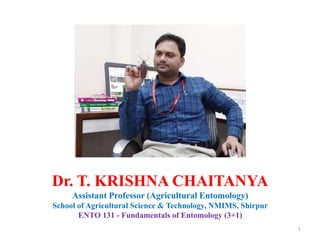
Fundamentals of Insect Sensory Organs
- 1. 1 Dr. T. KRISHNA CHAITANYA Assistant Professor (Agricultural Entomology) School of Agricultural Science & Technology, NMIMS, Shirpur ENTO 131 - Fundamentals of Entomology (3+1)
- 3. • Sensilla are the organs associated with sensory perception and develop from epidermal cells. • The different types of sense organs are: 1. Mechanoreceptors 2. Auditory receptors 3. Chemoreceptors 4. Thermo receptors and 5. Photo receptors 3
- 4. Category Function Examples Mechanoreceptors Detect movements, vibrations, or other mechanical disturbances Tactile receptors Proprioceptors Sound receptors Chemoreceptors Detect the presence of chemical substances in the air (smell) or on substrates (taste) Taste buds on palps Antennal sensilla Photoreceptors Detect the presence and quality of incident light (electromagnetic radiation) Compound eyes Ocelli 4
- 5. 1. Mechano receptors (detect mechanical forces) i. Trichoid sensilla: Hair like little sense organ. Sense cell associated with spur and seta. These cells are sensitive to touch and are located in antenna and trophi (mouth parts). 5
- 6. ii. Campaniform sensilla (Dome sensilla): Terminal end of these sensilla is rod like and inserted into dome shaped cuticula. These cells are sensitive to pressure and located in leg joints and wing bases. 6
- 7. iii. Chordotonal organ: The specialized sensory organs that receive vibrations are subcuticular mechano receptors called chordotonal organ. An organ consists of one to many scolopidia, each of which consists of cap cell, scolopale cell and dendrite. These organs are interoceptors attached to both ends of body wall. 7 Functions: i. Proprioception (positioning of their body parts in relation to the gravity). ii. Sensitive to sound waves, vibration of substratum and pressure changes.
- 8. iv. Johnston's organ: All adult’s insects and many larvae have a complex chordotonal organ called Johnston's organ lying within the second antennal segment (Pedicel). These organs sense movements of antennal flagellum. It also functions in hearing in some insects like male mosquitoes and midges. 8
- 9. v. Subgenual organ: Chordotonal organ located in the proximal tibia of each leg, used to detect substrate vibration. Subgenual organs are found in most insects, except the Coleoptera and Diptera 9
- 10. 2. Auditory receptors (detect sound waves) i. Delicate tactile hairs: Present in plumose antenna of male mosquito. 10
- 11. ii. Tympanum: This is a membrane stretched across tympanic cavity responds to sounds produced at some distance, transmitted by airborne vibration. Tympanal membranes are linked to chordotonal organs that enhance sound reception. 11
- 12. 12
- 13. 13 Figure 4. (Left) Side view and front view of the hearing organs on the legs of a cricket. (Center) A section across the leg of an insect showing the sensitive part of the hearing organ and the tympana. (Right) A hair that is sensitive to sound waves and its associated nerve cell.
- 14. Tympanal organs are located * Between the metathoracic legs of mantids. * The metathorax of many noctuid moths. * The prothoracic legs of many orthopterans. * The abdomen of short horned grasshopper, cicada. * The wings of certain moths and lacewings. 14
- 15. 3. Chemoreceptors (detect smell and taste) • Detect chemical energy. Insect chemoreceptors are sensilla with one pore (uniporous) or more pores (multiporous). Uniporous chemorceptors mostly detect chemicals of solid and liquid form by contact and are called as gustatory receptor. Many sensor neurons located in antenna are of this type. 15
- 16. • Multiporous chemoreceptors detect chemicals in vapour form, at distant by smell and are a called as olfactory receptor. Few sensory neurons located in trophi and tarsi are of this type. Each pore forms a chamber known as pore kettle with more number of pore tubules that run inwards to meet multi branched dendrites. 16
- 17. 17
- 18. 4. Thermoreceptors (detect heat) Present in poikilothermic insects and sensitive to temperature changes. In bed bug it is useful to locate the host utilizing the temperature gradient of the host. 18
- 19. 5. Photoreceptors (detect light energy) a. Compound eyes: The compound eye is based on many individual units called ommatidia. Each ommatidium is marked externally by a hexagonal area called facet. 19
- 20. 20
- 21. 21
- 22. 22 Fig. 2. Schematic Diagrams the (A) apposition and (B) refracting superposition eye. The optical path of the light is coloured grey and the target photoreceptor black. A = aperture diameter, f = focal length, c = corneal facet lens, cc = crystalline cones, p = screening pigment, rh = rhabdom, cz = clear zone, l = rhabdom length, and d = rhabdom diameter.
- 23. 23
- 24. b. Lateral ocelli (Stemmata): Visual organs of holometabolous larva. Structure is similar to ommatidium. It helps to detect form, colour and movement, and also to scan the environment. 24
- 25. c. Dorsal ocelli: Visual organs of nymph and it vary from 0-3 in numbers. It contains a single corneal lens with many visual cells individually secreting the rhabdomere. Dorsal ocelli perceive light to maintain diurnal rhythm and is not involved in image perception. 25
- 26. 26
- 27. 27